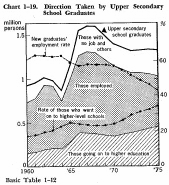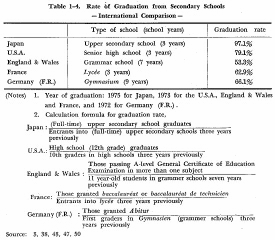| Home > Policy > White Paper, Notice, Announcement > White Paper > EDUCATIONAL STANDARDS IN JAPAN 1975 > CHAPTER1 3 (3) | ||
In 1975, 1,330,000 students graduated from upper secondary schools, of whom 34.2% or 450,000 went on to universities, junior colleges, etc. (This figure represents only those admitted to universities, junior colleges,etc. immediately after graduation from upper secondary schools, but includes those admitted to universities, junior colleges, etc. while entering employment at the same time; the same shall apply hereafter), 43.5% or 580,000 took employment (excluding those admitted to universities, junior colleges, etc. while taking employment at the same time), and 22.3% or 300,000 did not find employment or fell into other categories.
The number of upper secondary school graduates reached a peak of 1,600,000 in 1967 when the entrants into upper secondary schools in 1964 (when the number of upper secondary school students sharply increased) graduated. After exhibiting a downward trend untill 1972, it has remained at about the same level since 1973. The number of graduates who went on to institutions of higher education was on a downward trend from 1966 through 1970, but has been on the rebound since. On the other hand, the number of graduates who found employment has been on the decline since the peak of 940,000 was reached in 1968. While the number of graduates who did not find employment or fell into other categories has been on an upward trend particularly since 1965, the so-called Ronin, who spend extra years after graduation from upper secondary schools in preparatory studies for success in the entrance examination for universities, junior colleges, etc., (to be called Ronin students hereafter) come under this category of graduates.

In addition, the proportion in Japan of entrants into upper secondary schools who graduated therefrom after finishing the whole course is compared for reference with the proportion in several selected countries in Table 1-4 (Since the types and character of schools in these countries comparable to upper secondary schools of Japan are varied, the specified types of schools were chosen for convenience sake.).

According to this table, the rate of student graduation is the highest in upper secondary schools (full-time course) of Japan, with nearly all of the entrants being graduated. The percentage of students graduating from senior high schools of the U.S.A., which are considered as akin, in their character, to upper secondary schools of Japan, is lower than that of students graduating from upper secondary schools in Japan. The comparable figure in the three West European countries of England & Wales, France and the Federal Republic of Germany is considerably lower than that in Japan and the U.S.A. With respect to the percentage of students graduating in England & Wales, France and the Federal Republic of Germany, it should be borne in mind that the type of schools cited for reference here are designed chiefly to provide students with the kind of education for advancement to institutions of higher education, and that the school system as well as the system governing certification of student graduation, promotion and job seeking qualifications in these countries differ from those in Japan and the U.S.A.
| Back to Top | MEXT HOME |